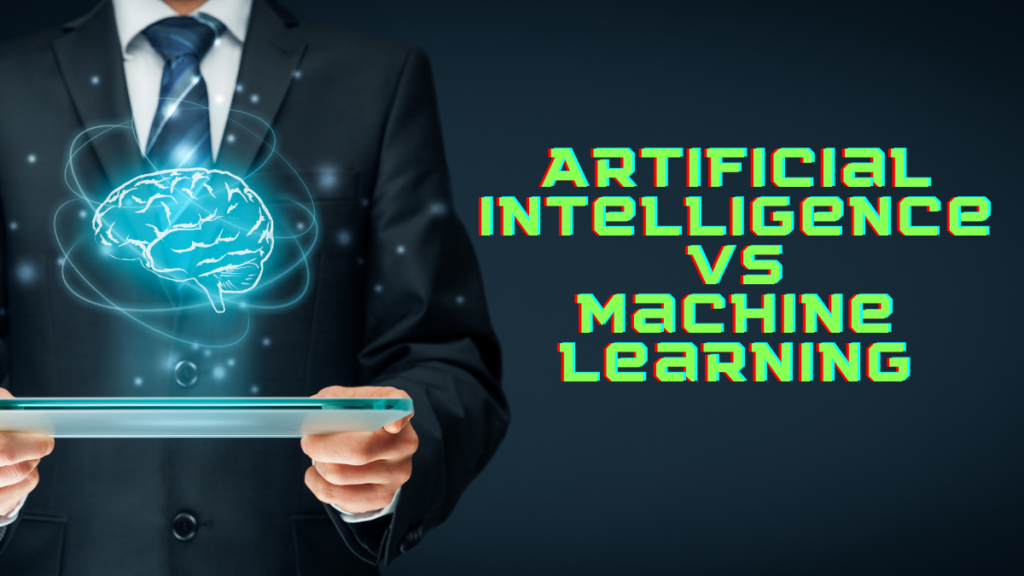Difference Between Artificial Intelligence and Machine Learning

Let’s face it. Machine Learning (ML) & Artificial Intelligence (AI) are the talks of the town (if you consider the whole world as one town!). The tech world is changing rapidly, and AI is arguably at the forefront of it. So, there’s a lot of chatter surrounding ML and AI.
Despite being inherently different, both terms are often used interchangeably.
We’ll say it: They are not quite the same thing. However, the perception that they are can sometimes lead to some confusion. And we’re ending this mix-up once and for all!
Let us clear the clouds of confusion and take a look at what differentiates AI from ML.

Understanding Artificial Intelligence
In simple terms, Artificial Intelligence (AI) is the intelligence demonstrated by machines or software. It is also a broad field of computer science that involves computers doing things that require “intelligence” when performed by humans.
AI research is based on the assumption that the human mind can be described as a set of problem-solving algorithms and can be simulated with enough computational power and data.
The field was founded on the claim (now known as the Turing test) that if a machine could be programmed with knowledge, skills, and abilities sufficient to pass for a human in conversation, then it would be able to perform tasks like simple reasoning and decision making which are generally agreed to require intelligence.
Understanding Machine Learning
Now let’s dive into the difference between artificial intelligence and machine learning.
ML is a subset of AI that focuses on enabling computers to learn without being explicitly programmed. In other words, it’s about using data to predict future events or behaviours rather than being told what those outcomes should be by an operator.
For example, let’s say you have a robot that is supposed to pick up a box and deliver it to another division of the factory. If you want your robot to pick up any box and deliver it, then all you need to do is a program with instructions like “pick up” or “deliver.”
But suppose you want your robot to recognise which boxes are worth picking up based on their contents (i.e., they contain valuable materials). In that case, programming them individually becomes very inefficient because there could be thousands or even millions of different types of valuable materials that are delivered throughout the day!
To solve this problem with traditional programming methods, we use machine learning algorithms – specifically neural networks – which allow for more efficient transferral from input data (the images) into prediction output (like boxes containing valuable materials).
Components of Machine Learning
As we already know, ML deals with systems that can learn from the available data, analyse it, and draw inferences from it.
In this sense, machine learning can be seen as an advancement over traditional programming, where software researchers have to write code for every possible scenario.
In machine learning, you give your system some inputs and expected outputs (training data) which it then uses to learn the patterns in this dataset so that when new inputs come in, it can predict the correct output based on past experiences.
This is why we often refer to ML algorithms as models because they essentially build up a model of how things work by analysing data samples given during training time.
Breakdown of Machine Learning
Machine learning can be divided into two categories: supervised and unsupervised.
- Supervised learning
Supervised learning is a machine learning task where we have labelled data. For example, we have labelled images as containing cats and dogs. In this case, we know what the output should be for a particular input.
Many people think about ML algorithms—yielding a result from a known input. However, many other types of supervised learning can be used to perform tasks like fraud detection or recommendation systems (which use customer data) in which we don’t know exactly what our outputs should look like but instead can only provide some guidance on what they might look like given certain inputs.
- Unsupervised learning
Unsupervised learning is used when there isn’t any known input/output relationship in your data set, and you just want to find structure or patterns within it without having any idea what they will be before looking at them with an algorithm such as k-means clustering or principal component analysis (PCA).
Applications of AI and ML
AI is used in many applications, such as image recognition, speech recognition, machine translation, and natural language processing. AI can also be used in medical diagnosis.
Machine learning helps computers learn through experience. Learnable models are created using ML algorithms to build a model based on data previously given to the system by its users or administrators.
Both are concerned with developing computer systems that can perform tasks normally done by humans more quickly and efficiently than they could do themselves—that is to say, they both want to simulate human intelligence with machines.
However, while AI tries its best to replicate this intelligence by creating rules-based programs or neural networks which function like the brain does when we think about something new; ML tries its best further understand complex systems through statistical analysis and pattern recognition so as not necessarily mimic how humans think but what works best for them instead.
Intricacies of AI
Artificial intelligence (AI) is a field in computer science that aims to create Intelligent machines that work and react like humans. AI systems can be categorised into three types:
- Artificial general intelligence: A self-aware computer capable of performing any intellectual task a human can, such as driving cars, writing poetry, and playing chess.
- Narrow artificial intelligence (NAI): Technology specialising in one specific function, for example, identifying objects or predicting the stock market.
- Superintelligence: A machine with greater cognitive ability than any human being on Earth; some consider this type of AI dangerous because it could lead to world domination or widespread unemployment if the superintelligent machine decides humans are worthless or inefficient.
Artificial Intelligence Vs Machine learning: In A Nutshell
So folks, all of this comes down to this – Artificial intelligence (AI) is the branch of CS (Computer Science) that deals with making computers behave like humans. AI involves machines performing tasks and solving problems automatically without any human intervention.
On the flip side, Machine learning (ML) is a subset of artificial intelligence (AI) that focuses on empowering computers to learn from data without being explicitly programmed.
Machine learning aims to build programs that can act in an “intelligent” manner by themselves based on experience rather than being told how to act. Machine learning uses statistical techniques to allow computers to “learn,” i.e., progressively improve performance on a specific task, without being explicitly programmed.
We hope this article helped you differentiate ML from AI. TeCuriosity strives to bring such mind-engaging stories to you regularly. So, don’t forget to hit subscribe to our newsletter button for more Curiosity-fuelling content!












